Abstract
The differences in susceptibility among C57Bl/6, DBA/2 mice and their F1 hybrids to infections with M. lepraemurium were shown to depend upon the route of infection and size of the inoculum. A method was developed to measure the ability of lymphocytes obtained from M. lepraemurium-infected donors to effect adoptive immunization of syngeneic naive mice against infection with M. tuberculosis. This required sublethal irradiation of recipient mice prior to cell transfer and bacterial challenge. Using this method, it was found that mice infected subcutaneously generated antituberculous immune mechanisms concordantly with the development of delayed-hypersensitivity to antigens of M. lepraemurium. In contrast, intravenously infected mice demonstrated only a transient from of delayed hypersensitivity and little or no antimycobacterial immunity in that progression of infection was associated with a rapid decay of both these functions. Moreover, during the terminal stage, M. lepraemurium-infected mice lost the ability to control the growth of a sublethal intravenous inoculum of the antigenically unrelated bacterium. Listeria monocytogenes.
Full text
PDF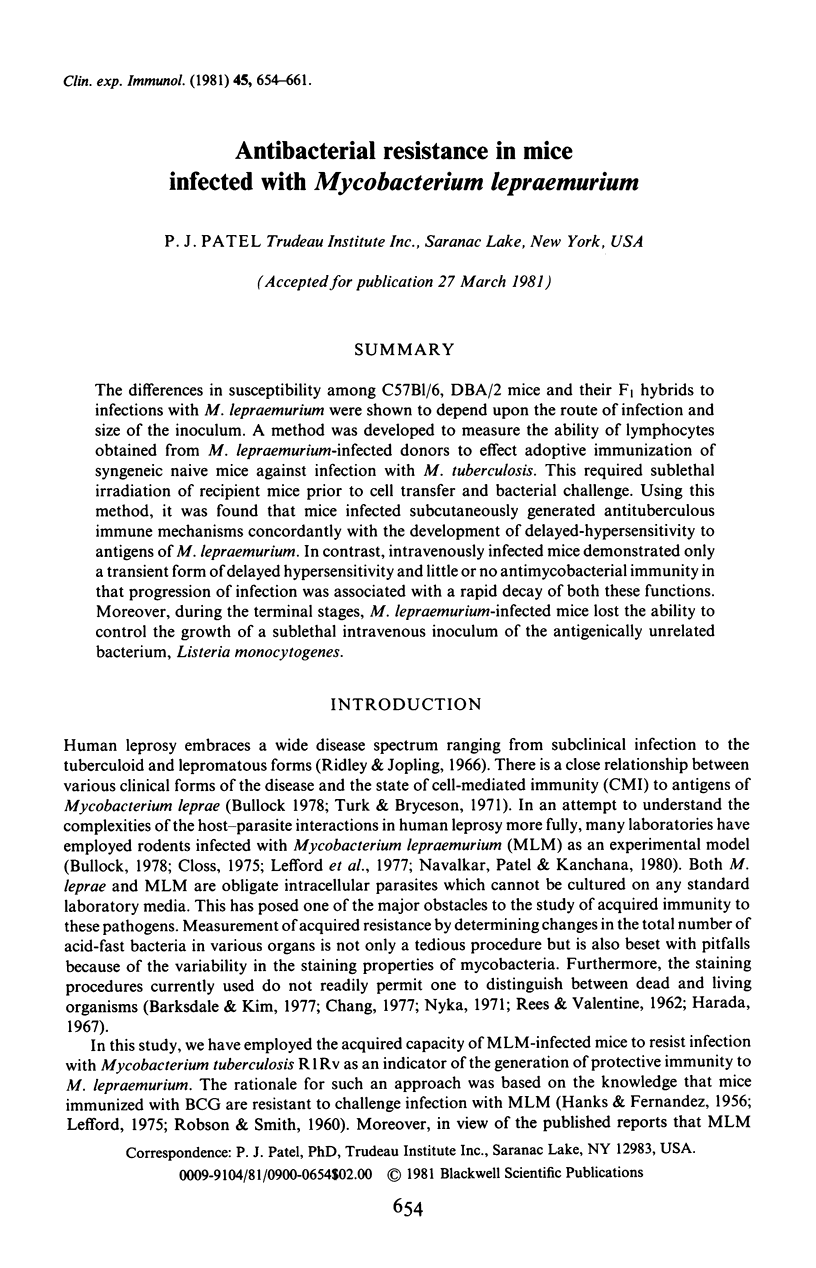
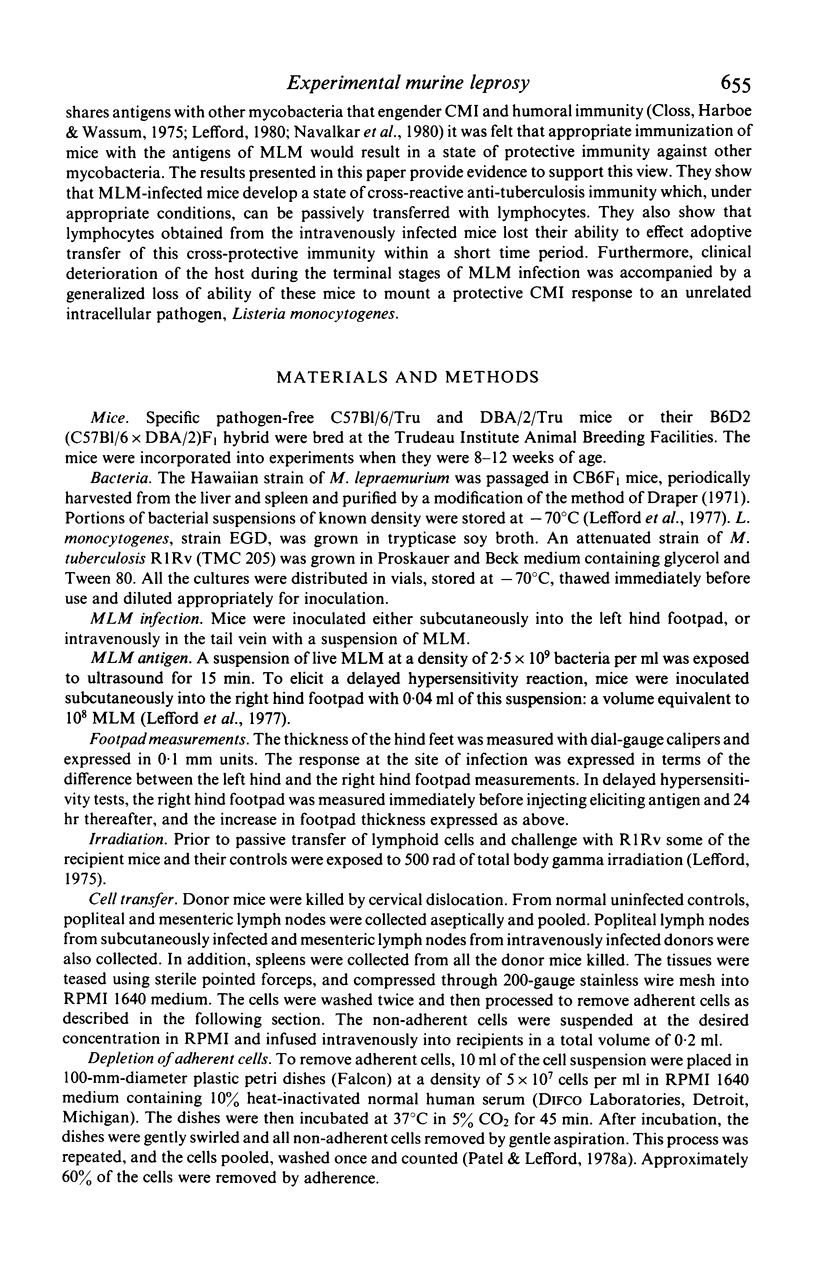
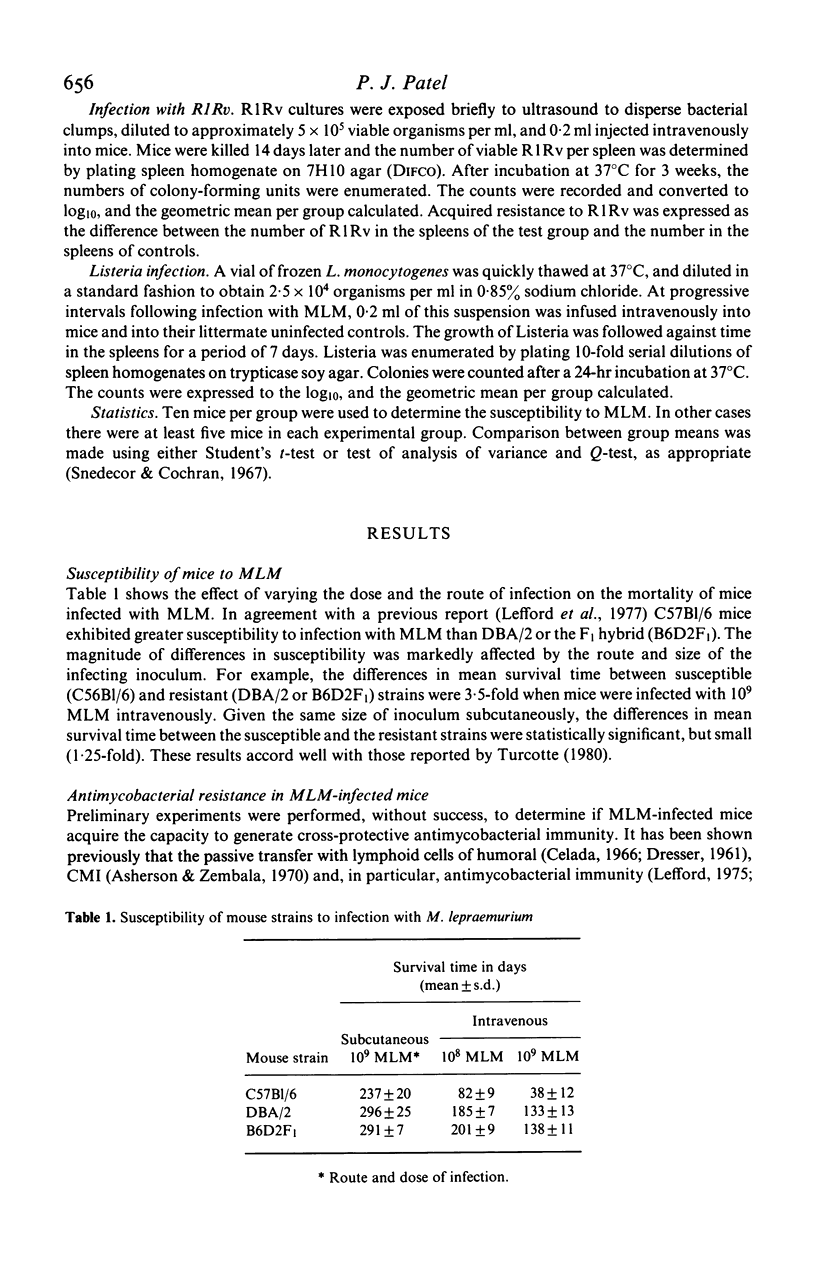
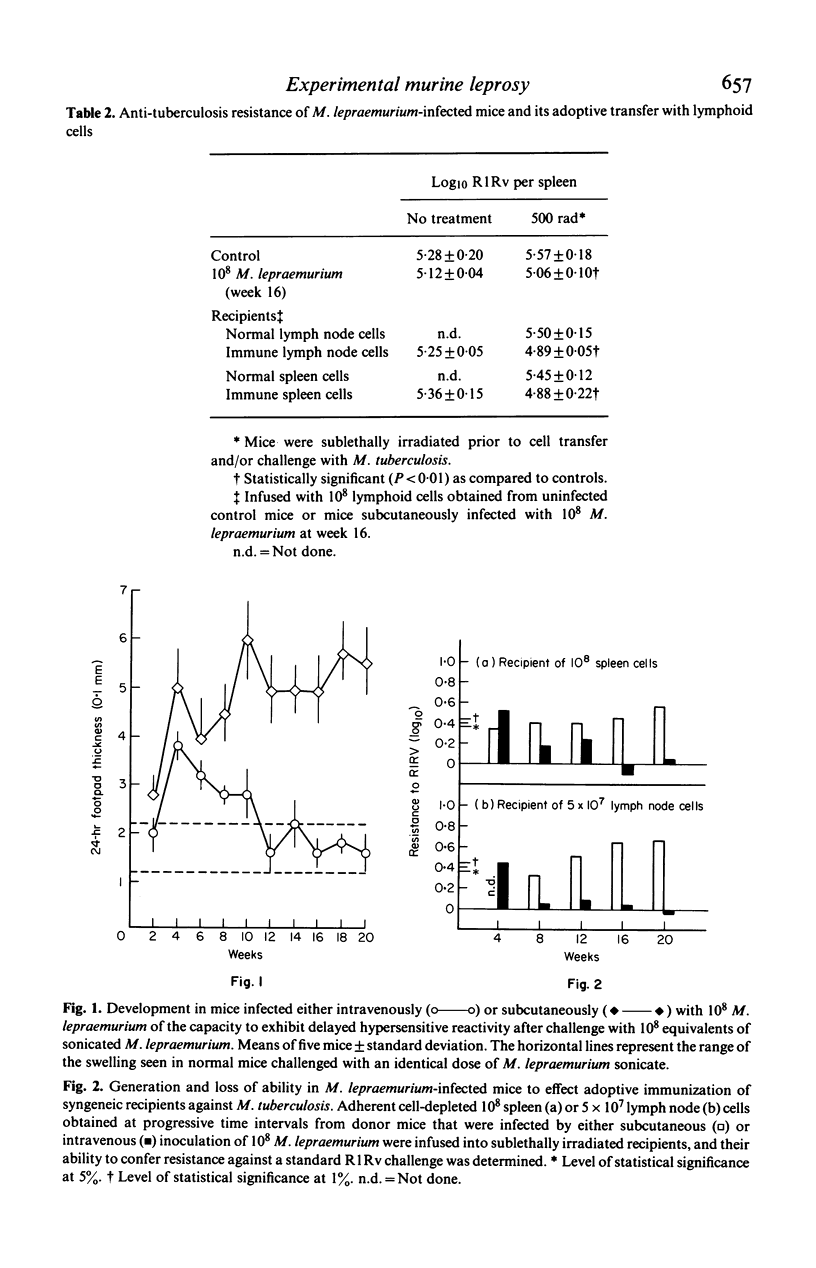
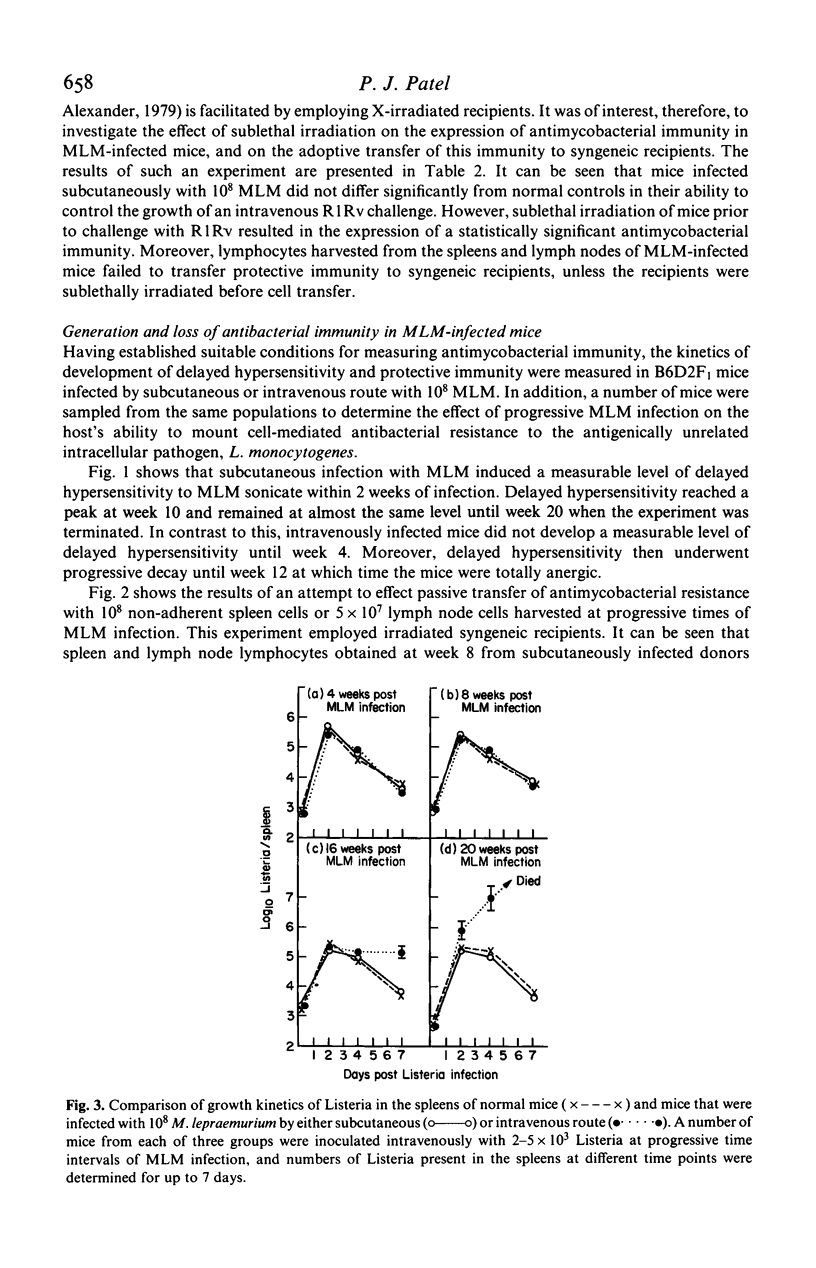
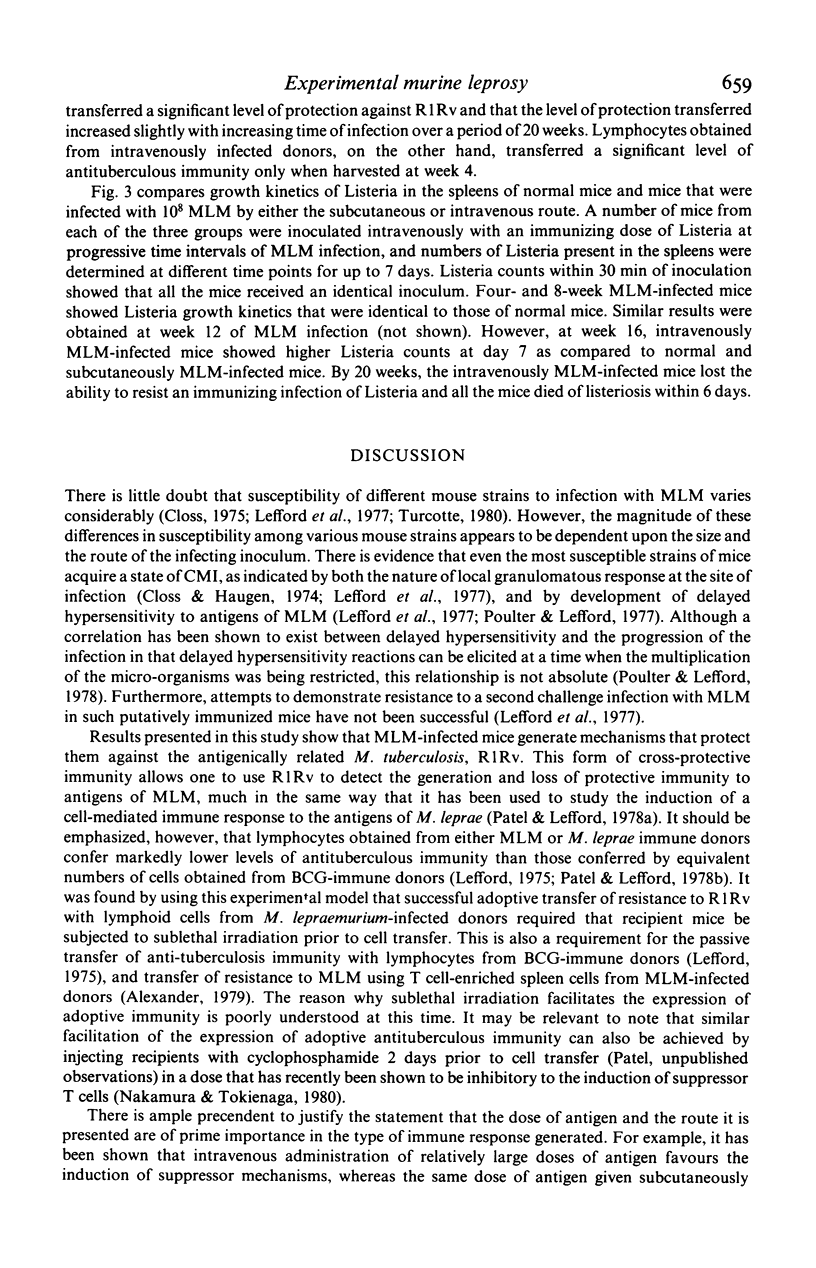
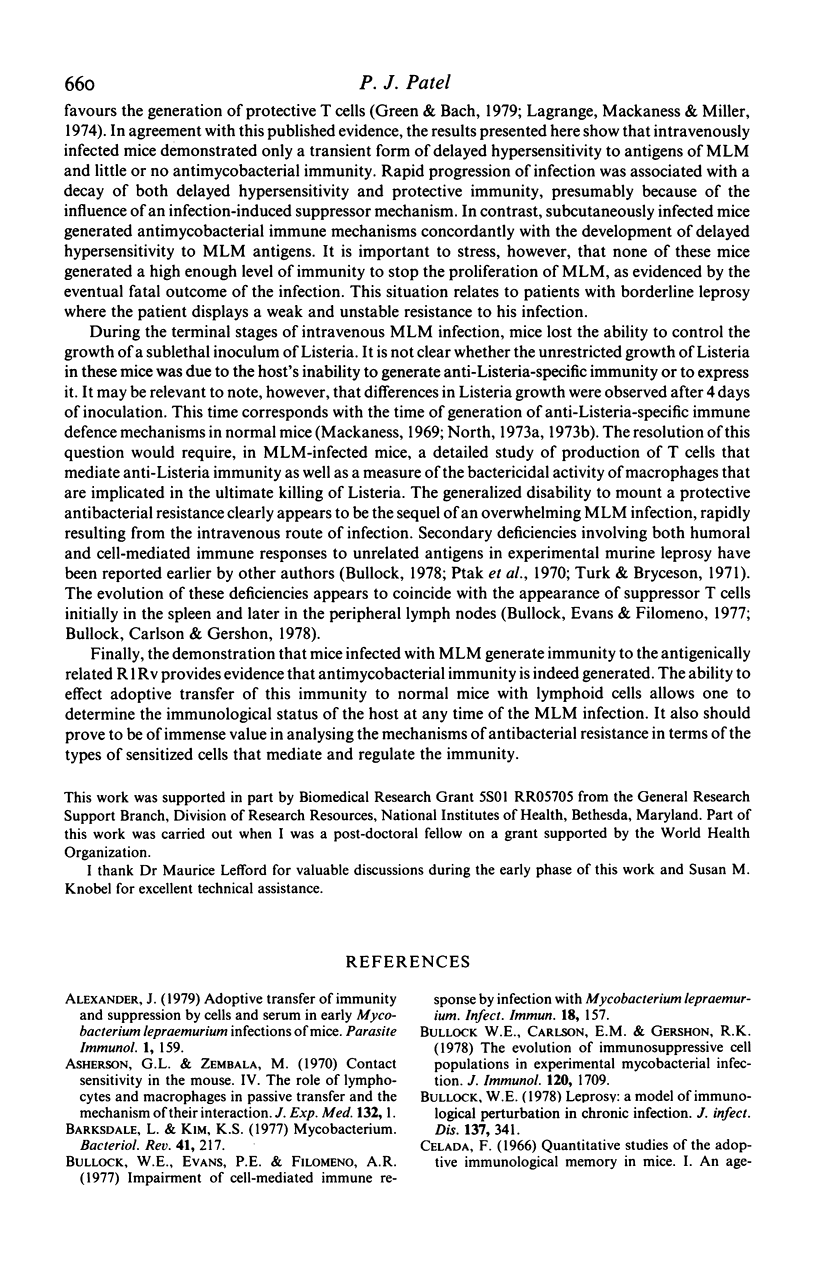
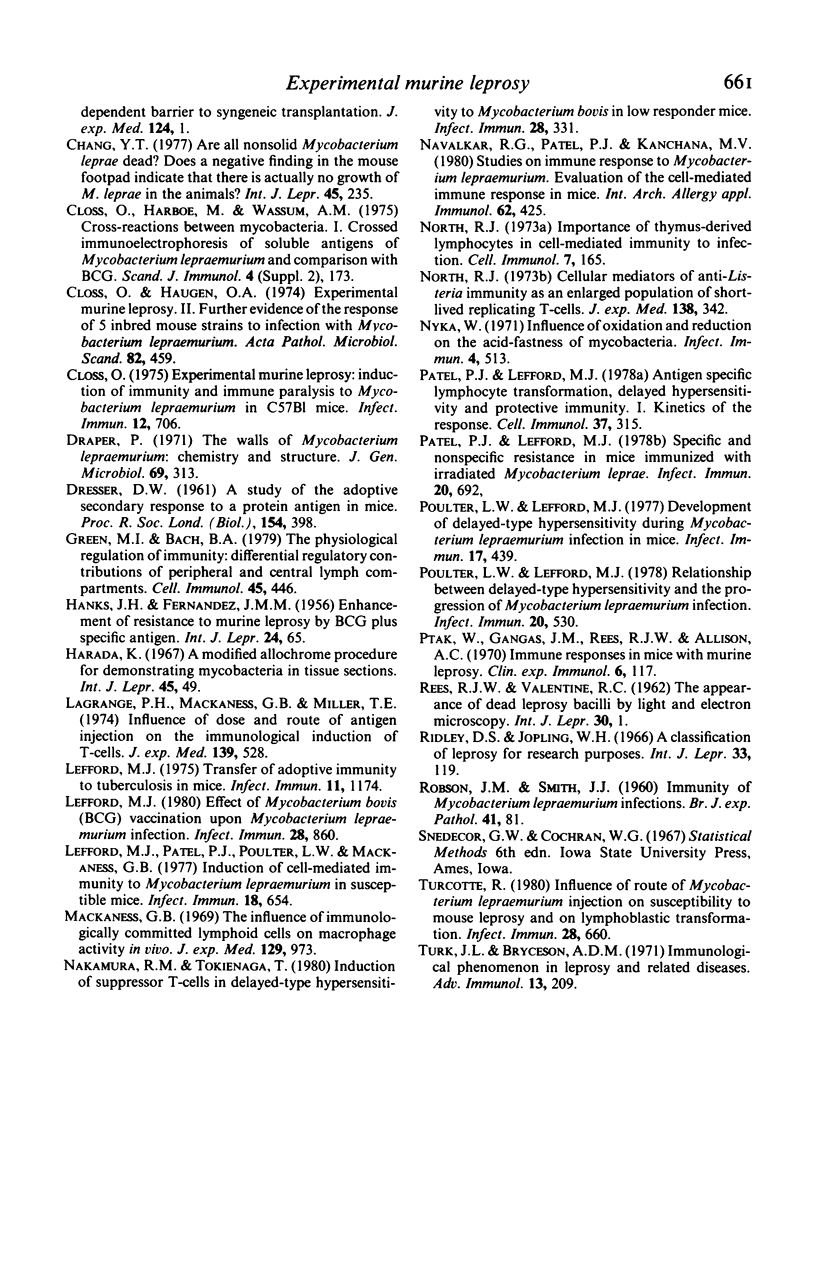
Selected References
These references are in PubMed. This may not be the complete list of references from this article.
- Alexander J. Adoptive transfer of immunity and suppression by cells and serum in early Mycobacterium lepraemurium infections of mice. Parasite Immunol. 1979 Summer;1(2):159–166. doi: 10.1111/j.1365-3024.1979.tb00703.x. [DOI] [PubMed] [Google Scholar]
- Asherson G. L., Zembala M. Contact sensitivity in the mouse. IV. The role of lymphocytes and macrophages in passive transfer and the mechanism of their interaction. J Exp Med. 1970 Jul 1;132(1):1–15. doi: 10.1084/jem.132.1.1. [DOI] [PMC free article] [PubMed] [Google Scholar]
- Barksdale L., Kim K. S. Mycobacterium. Bacteriol Rev. 1977 Mar;41(1):217–372. doi: 10.1128/br.41.1.217-372.1977. [DOI] [PMC free article] [PubMed] [Google Scholar]
- Bullock W. E., Carlson E. M., Gershon R. K. The evolution of immunosuppressive cell populations in experimental mycobacterial infection. J Immunol. 1978 May;120(5):1709–1716. [PubMed] [Google Scholar]
- Bullock W. E., Evans P. E., Filomeno A. R. Impairment of cell-mediated immune responses by infection with Mycobacterium lepraemurium. Infect Immun. 1977 Oct;18(1):157–164. doi: 10.1128/iai.18.1.157-164.1977. [DOI] [PMC free article] [PubMed] [Google Scholar]
- Bullock W. E. Leprosy: a model of immunological perturbation in chronic infection. J Infect Dis. 1978 Mar;137(3):341–354. doi: 10.1093/infdis/137.3.341. [DOI] [PubMed] [Google Scholar]
- Celada F. Quantitative studies of the adoptive immunological memory in mice. I. An age-dependent barrier to syngeneic transplantation. J Exp Med. 1966 Jul 1;124(1):1–14. doi: 10.1084/jem.124.1.1. [DOI] [PMC free article] [PubMed] [Google Scholar]
- Chang Y. T. Are all nonsolid Mycobacterium leprae dead? Does a negative finding in the mouse foot pad indicate that there is actually no growth of M. leprae in the animals? Int J Lepr Other Mycobact Dis. 1977 Jul-Sep;45(3):235–240. [PubMed] [Google Scholar]
- Closs O. Experimental murine leprosy: induction of immunity and immune paralysis to Mycobacterium lepraemurium in C57BL mice. Infect Immun. 1975 Oct;12(4):706–713. doi: 10.1128/iai.12.4.706-713.1975. [DOI] [PMC free article] [PubMed] [Google Scholar]
- Closs O., Haugen O. A. Experimental murine leprosy. 2. Further evidence for varying susceptibility of outbred mice and evaluation of the response of 5 inbred mouse strains to infection with Mycobacterium lepraemurium. Acta Pathol Microbiol Scand A. 1974 Jul;82(4):459–474. [PubMed] [Google Scholar]
- DRESSER D. W. A study of the adoptive secondary response to a protein antigen in mice. Proc R Soc Lond B Biol Sci. 1961 Jul 25;154:398–417. doi: 10.1098/rspb.1961.0039. [DOI] [PubMed] [Google Scholar]
- Draper P. The walls of Mycobacterium lepraemurium: chemistry and ultrastructure. J Gen Microbiol. 1971 Dec;69(3):313–324. doi: 10.1099/00221287-69-3-313. [DOI] [PubMed] [Google Scholar]
- FERNANDEZ J. M., HANKS J. H. Enhancement of resistance to murine leprosy by BCG plus specific antigen. Int J Lepr. 1956 Jan-Mar;24(1):65–73. [PubMed] [Google Scholar]
- Greene M. I., Bach B. A. Hypothesis. The physiological regulation of immunity: differential regulatory contributions of peripheral and central lymphon compartments. Cell Immunol. 1979 Jul;45(2):446–451. doi: 10.1016/0008-8749(79)90404-0. [DOI] [PubMed] [Google Scholar]
- Harada K. A modified allochrome procedure for demonstrating mycobacteria in tissue sections. Int J Lepr Other Mycobact Dis. 1977 Jan-Mar;45(1):49–51. [PubMed] [Google Scholar]
- Lagrange P. H., Mackaness G. B., Miller T. E. Influence of dose and route of antigen injection on the immunological induction of T cells. J Exp Med. 1974 Mar 1;139(3):528–542. doi: 10.1084/jem.139.3.528. [DOI] [PMC free article] [PubMed] [Google Scholar]
- Lefford M. J., Morgan R., Logie P. S. Effect of Mycobacterium bovis BCG vaccination upon Mycobacterium lepraemurium infection. Infect Immun. 1980 Jun;28(3):860–866. doi: 10.1128/iai.28.3.860-866.1980. [DOI] [PMC free article] [PubMed] [Google Scholar]
- Lefford M. J., Patel P. J., Poulter L. W., Mackaness G. B. Induction of cell-mediated immunity to Mycobacterium lepraemurium in susceptible mice. Infect Immun. 1977 Dec;18(3):654–659. doi: 10.1128/iai.18.3.654-659.1977. [DOI] [PMC free article] [PubMed] [Google Scholar]
- Lefford M. J. Transfer of adoptive immunity to tuberculosis in mice. Infect Immun. 1975 Jun;11(6):1174–1181. doi: 10.1128/iai.11.6.1174-1181.1975. [DOI] [PMC free article] [PubMed] [Google Scholar]
- Mackaness G. B. The influence of immunologically committed lymphoid cells on macrophage activity in vivo. J Exp Med. 1969 May 1;129(5):973–992. doi: 10.1084/jem.129.5.973. [DOI] [PMC free article] [PubMed] [Google Scholar]
- Nakamura R. M., Tokunaga T. Induction of suppressor T cells in delayed-type hypersensitivity to Mycobacterium bovis BCG in low-responder mice. Infect Immun. 1980 May;28(2):331–335. doi: 10.1128/iai.28.2.331-335.1980. [DOI] [PMC free article] [PubMed] [Google Scholar]
- North R. J. Cellular mediators of anti-Listeria immunity as an enlarged population of short lived, replicating T cells. Kinetics of their production. J Exp Med. 1973 Aug 1;138(2):342–355. doi: 10.1084/jem.138.2.342. [DOI] [PMC free article] [PubMed] [Google Scholar]
- Nyka W. Influence of oxidation and reduction on the acid-fastness of mycobacteria. Infect Immun. 1971 Oct;4(4):513–515. doi: 10.1128/iai.4.4.513-515.1971. [DOI] [PMC free article] [PubMed] [Google Scholar]
- Patel P. J., Lefford M. J. Antigen specific lymphocyte transformation, delayed hypersensitivity and protective immunity. I. Kinetics of the response. Cell Immunol. 1978 May;37(2):315–326. doi: 10.1016/0008-8749(78)90200-9. [DOI] [PubMed] [Google Scholar]
- Patel P. J., Lefford M. J. Specific and nonspecific resistance in mice immunized with irradiated Myobacterium leprae. Infect Immun. 1978 Jun;20(3):692–697. doi: 10.1128/iai.20.3.692-697.1978. [DOI] [PMC free article] [PubMed] [Google Scholar]
- Poulter L. W., Lefford M. J. Development of delayed-type hypersensitivity during Mycobacterium lepraemurium infection in mice. Infect Immun. 1977 Aug;17(2):439–446. doi: 10.1128/iai.17.2.439-446.1977. [DOI] [PMC free article] [PubMed] [Google Scholar]
- Poulter L. W., Lefford M. J. Relationship between delayed-type hypersensitivity and the progression of Mycobacterium lepraemurium infection. Infect Immun. 1978 May;20(2):530–540. doi: 10.1128/iai.20.2.530-540.1978. [DOI] [PMC free article] [PubMed] [Google Scholar]
- Ptak W., Gaugas J. M., Rees R. J., Allison A. C. Immune responses in mice with murine leprosy. Clin Exp Immunol. 1970 Jan;6(1):117–124. [PMC free article] [PubMed] [Google Scholar]
- REES R. J., VALENTINE R. C. The appearance of dead leprosy bacilli by light and electron microscopy. Int J Lepr. 1962 Jan-Mar;30:1–9. [PubMed] [Google Scholar]
- RIDLEY D. S., JOPLING W. H. A classification of leprosy for research purposes. Lepr Rev. 1962 Apr;33:119–128. doi: 10.5935/0305-7518.19620014. [DOI] [PubMed] [Google Scholar]
- ROBSON J. M., SMITH J. T. Immunity in Mycobacterium lepraemurium infections. Br J Exp Pathol. 1960 Feb;41:81–85. [PMC free article] [PubMed] [Google Scholar]
- Turcotte R. Influence of route of Mycobacterium lepraemurium injection on susceptibility to mouse leprosy and on lymphoblastic transformation. Infect Immun. 1980 Jun;28(3):660–668. doi: 10.1128/iai.28.3.660-668.1980. [DOI] [PMC free article] [PubMed] [Google Scholar]
- Turk J. L., Bryceson A. D. Immunological phenomena in leprosy and related diseases. Adv Immunol. 1971;13:209–266. doi: 10.1016/s0065-2776(08)60185-6. [DOI] [PubMed] [Google Scholar]


